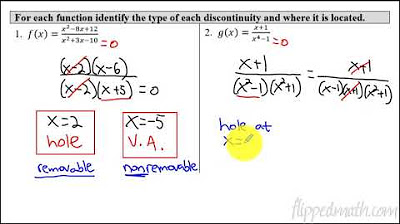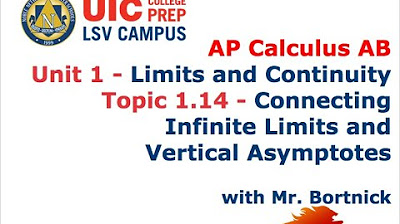AP Calculus AB - 1.10 Exploring Types of Discontinuities
TLDRIn this AP Calculus AB video, Mr. Bortnick explores the concept of discontinuities in functions, providing an informal definition of continuity as the ability to draw a function without lifting the pencil. He categorizes functions as either continuous or discontinuous and delves into types of discontinuities, including holes, vertical asymptotes, and jumps. Through examples and factoring, he teaches how to identify and categorize discontinuities, emphasizing the importance of the denominator in causing discontinuities. The lesson also covers trigonometric functions and the behavior of polynomials, aiming to help students master the topic.
Takeaways
- 📝 Today's topic is exploring types of discontinuities in functions.
- 🔄 Informal definition of continuity: a function is continuous if it can be drawn without lifting the pencil.
- ✅ A function can be continuous or discontinuous on different intervals of its domain.
- 📉 Example of a continuous function: one that can be drawn from start to end without lifting the pencil.
- 🚫 Example of a discontinuous function: one that requires lifting the pencil due to an asymptote or break.
- 🔍 Types of discontinuities: holes (removable), vertical asymptotes (non-removable), and skips/jumps (non-removable).
- 🔗 Factors canceling in a function's fraction indicate a hole (removable discontinuity).
- 🚧 Non-canceling factors in a function's fraction indicate a vertical asymptote (non-removable discontinuity).
- 🔄 In trigonometric functions like tan(x), discontinuities occur where the cosine is zero.
- 📉 Polynomial functions without denominators are generally continuous and well-behaved.
Q & A
What is the informal definition of continuity as described in the script?
-The informal definition of continuity is the ability to draw a function without lifting up your pencil, indicating that the function is either continuous or discontinuous based on this criterion.
What are the three types of discontinuities mentioned in the script?
-The three types of discontinuities mentioned are: a hole in the function, a vertical asymptote, and a skip or jump in the graph.
What is a removable discontinuity and how is it different from a non-removable discontinuity?
-A removable discontinuity is a hole in the function that can be 'filled in' to make the function continuous, whereas a non-removable discontinuity, such as a vertical asymptote or a skip/jump, cannot be fixed by simply filling in a point.
How can you determine if a discontinuity is a hole or a vertical asymptote when factoring a function?
-If a factor in the denominator cancels with a factor in the numerator, it results in a hole. If the factor in the denominator does not cancel with any factor in the numerator, it results in a vertical asymptote.
What is the significance of the denominator in determining discontinuities in a function?
-The denominator is significant because a discontinuity occurs whenever the denominator equals zero, as division by zero is undefined, which can lead to a hole, vertical asymptote, or other types of discontinuities.
Why is the function x^2 - 8x + 12 / (x^2 + 3x - 10) discontinuous at x = -5 and x = 2?
-The function is discontinuous at x = -5 and x = 2 because these values make the denominator equal to zero, resulting in a vertical asymptote at x = -5 and a hole at x = 2 due to the cancellation of the (x - 2) factor in the numerator.
How does the script suggest factoring the function g(x) = (x + 1) / (x^4 - 1) to identify discontinuities?
-The script suggests using the difference of squares formula to factor x^4 - 1 into (x^2 + 1)(x^2 - 1), and further factor x^2 - 1 into (x + 1)(x - 1), which helps identify discontinuities at x = -1 and x = 1.
What trigonometric identity is used in the script to rewrite the function h(x) = tan(2x) and why?
-The identity tan(x) = sin(x) / cos(x) is used to rewrite h(x) as sin(2x) / cos(2x) to identify the points where the cosine function equals zero, which would indicate discontinuities in the tangent function.
Why are polynomial functions without denominators considered 'well-behaved' in terms of continuity?
-Polynomial functions without denominators are considered 'well-behaved' because they do not have discontinuities such as holes or vertical asymptotes, and they represent smooth curves without breaks.
What is the significance of the unit circle in identifying discontinuities in trigonometric functions like tan(x)?
-The unit circle is significant because it helps identify the angles at which trigonometric functions like cosine are equal to zero, which in turn helps determine the vertical asymptotes in the graph of the tangent function.
What is the purpose of the practice problems and mastery check mentioned in the script?
-The practice problems and mastery check are meant to reinforce the understanding of the concepts taught in the script, specifically the identification and categorization of different types of discontinuities in functions.
Outlines
📚 Introduction to Continuity and Discontinuities
Mr. Bortnick introduces the concept of continuity and discontinuities in calculus, focusing on the informal definition of continuity as the ability to draw a function without lifting the pencil. He distinguishes between continuous and discontinuous functions and hints at the mathematical definition to be covered in upcoming lessons. The instructor uses visual examples to illustrate continuous and discontinuous functions, including those with holes, vertical asymptotes, and jumps, categorizing them into removable and non-removable discontinuities.
🔍 Exploring Types of Discontinuities
The video delves deeper into the types of discontinuities, explaining vertical asymptotes as non-removable discontinuities that prevent drawing a function without lifting the pencil. The instructor provides a rule for identifying discontinuities by examining the factors in the numerator and denominator of a function. If factors cancel out, it results in a hole or removable discontinuity; otherwise, it indicates a vertical asymptote or non-removable discontinuity. The lesson includes an example of identifying discontinuities in a given function by factoring and analyzing the resulting equation.
📘 Factoring to Determine Discontinuities
Continuing the discussion on discontinuities, Mr. Bortnick emphasizes the importance of factoring to determine whether a discontinuity is a hole or a vertical asymptote. He provides a step-by-step guide on how to factor expressions and use the resulting factors to identify the type of discontinuity. The video includes examples of functions with discontinuities and demonstrates the process of factoring to find the points where the discontinuities occur.
📐 Trigonometric Functions and Discontinuities
The instructor introduces the concept of discontinuities in trigonometric functions, specifically focusing on the tangent function. By rewriting the tangent function in terms of sine and cosine, the video explains how to identify vertical asymptotes in trigonometric functions. The lesson includes an example of finding discontinuities in the tangent function by setting the denominator equal to zero and solving for the angle, which corresponds to the x-values where discontinuities occur.
📈 Polynomial Functions and Their Behavior
In the final part of the script, Mr. Bortnick discusses the behavior of polynomial functions without denominators, which are typically continuous and well-behaved. He explains that these functions do not have holes or vertical asymptotes and are characterized by their smooth, parabolic shapes. The instructor provides a brief overview of identifying continuous functions and encourages students to practice the concepts covered in the lesson and complete a mastery check.
Mindmap
Keywords
💡Continuity
💡Discontinuities
💡Removable Discontinuity
💡Non-Removable Discontinuity
💡Vertical Asymptote
💡Factoring
💡Hole
💡Polynomial Functions
💡Tangent Function
💡Unit Circle
Highlights
Introduction to the concept of continuity and informal definition: A function is continuous if it can be drawn without lifting the pencil.
Differentiation between continuous and discontinuous functions based on the ability to draw the function without interruption.
Exploration of discontinuities, including removable and non-removable types, with examples provided.
Removable discontinuities are characterized by holes in the graph, which can be 'filled in' to restore continuity.
Non-removable discontinuities include vertical asymptotes and skip/jumps, which cannot be corrected by filling in points.
Identification of discontinuities through factoring and analyzing the numerator and denominator of a function.
Rule for determining if a discontinuity is a hole or a vertical asymptote based on factor cancellation.
Application of the difference of squares factoring technique to identify discontinuities.
Use of trigonometric identities to rewrite and analyze functions for potential discontinuities.
Understanding that the cosine function equals zero at specific angles, leading to vertical asymptotes in tangent functions.
Identification of vertical asymptotes in the tangent function by setting the cosine of 2x to zero.
Explanation of why polynomial functions without denominators are considered 'well-behaved' and continuous.
Emphasis on the importance of factoring in determining the type and location of discontinuities.
Instruction on how to identify and categorize discontinuities in given functions through examples.
Note on the upcoming video providing unit circle tips and tricks for better understanding of trigonometric functions.
Conclusion of the lesson with a reminder to complete practice problems and a mastery check for the topic.
Transcripts
Browse More Related Video
5.0 / 5 (0 votes)
Thanks for rating:





